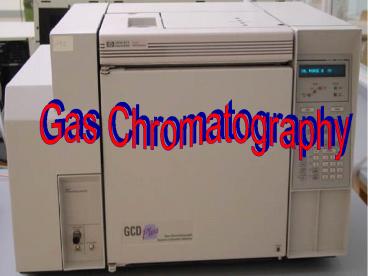Gas Chromatography - PowerPoint PPT Presentation
Title:
Gas Chromatography
Description:
High Performance Liquid Chromatography HPLC originally refered to: High Pressure Liquid Chromatography currently refers to: High Precision Liquid Chromatography high ... – PowerPoint PPT presentation
Number of Views:149
Avg rating:3.0/5.0
Title: Gas Chromatography
1
Gas Chromatography
2
- http//www.studyhplc.com/chromatographyanimation.p
hp
3
Major Components
http//www.wooster.edu/chemistry/analytical/gc/def
ault.html
4
(No Transcript)
5
- Column Stationary Phases
- Packed
- - liquid coated silica particles (lt100-300 mm
diameter) in glass tube - best for large scale but slow and inefficient
- Capillary/Open Tubular
- - wall-coated (WCOT) lt1 mm thick liquid coating
on inside of silica tube - - support-coated (SCOT) 30 mm thick coating of
liquid-coated support on inside of silica - tube
- - best for speed and efficiency but only small
samples diameter 150-400 mm
6
Why are modern GC based on a capillary
column? Back to the van Deemter Eqn. H A B/n
Cn Remember, n flow rate, A multiple
paths, B/n longitudinal diffusion effects, Cn
MT effects We want to minimize H as much as
possible.
7
Many based on polysiloxanes or polyethylene
glycol (PEG)
8
Non-polar stationary phases best for non-polar
analytes non-polar analytes retained
preferentially Polar stationary phases best for
polar analytes polar analytes retained
preferentially
9
- Temperature Programming
- As column temperature raised, vapor pressure
analyte increases, eluted faster - - Raise column temperature during separation
temperature programming separates species with
wide range of polarities or vapor pressures
10
Sample Injection
11
GC Injection Syringe It is important to rapidly
vaporize the sample. Slow vaporization increases
band broadening, by increasing the sample
plug. Injection port temperature is usually
held 50oC higher than the BP of the least
volatile compounds.
GC injection and band broadening and anomalies.
Extremely slow injections will cause
band-broadening, wide sample plug. Jerky
injections may cause double peaks for the same
analyte species.
12
Split vs. Splitless Injection Sample injection
is done by a syringe 1 to 5 µL or ngs of
analyte for the average capillary
column. Capillary columns usually require split
in injections, a sample reduction
method. Depending on the spilt ratio
(adjustable) only 0.2 to 2 of the sample
injection makes its way to the column. The rest
is discarded.
Split
Splitless
13
(No Transcript)
14
- GC Detectors
- Ideal detector characteristics, for flowing
systems (e.g. GC) - large dynamic/linear range
- response independent of flow rate, i.e. fast
response times - Universal detection, responds to all species.
- Keep this in mind when we discuss HPLC and CE.
- Additional requirements for GC
- operation from RT to 400 oC
- - detector response independent of detector oven T
15
- Flame Ionization Detector (FID).
- -Sensitive towards organics
- Analyte is burned in H2/air, which produces CH
and CHO, radicals, remember our discussion
regarding the blue cone in AA. - CHO radicals are reduced at a cathode which
produces a current proportional to the radical
quantity. About 10-12 amps - Specific for organic carbon, insensitive to
inorganics, CO2, SO2 etc. - - Response to specific organic depends on the
number of organic carbons.
16
Electron Capture Detector (ECD) Sensitive to
electron withdrawing groups especially towards
organics containing F, -Cl, -Br, -I also, -CN,
NO2 Nickel-63 source emits energetic electrons
collides with N2 (introduced as make-up gas or
can be used as carrier gas) producing more
electrons Ni-63 ? e- N2 ? 2e- N2 The
result is a constant current that is detected by
the electron collector (anode).
17
(No Transcript)
18
GC-MS offers structural determinations With
other detectors identification is possible with
retention times of analyte and standard, however
its best if another method is used as
a confirmation.














![Lecture note : Gas chromatography [1] ????????? PowerPoint PPT Presentation](https://s3.amazonaws.com/images.powershow.com/6692254.th0.jpg?_=20150604093)
















